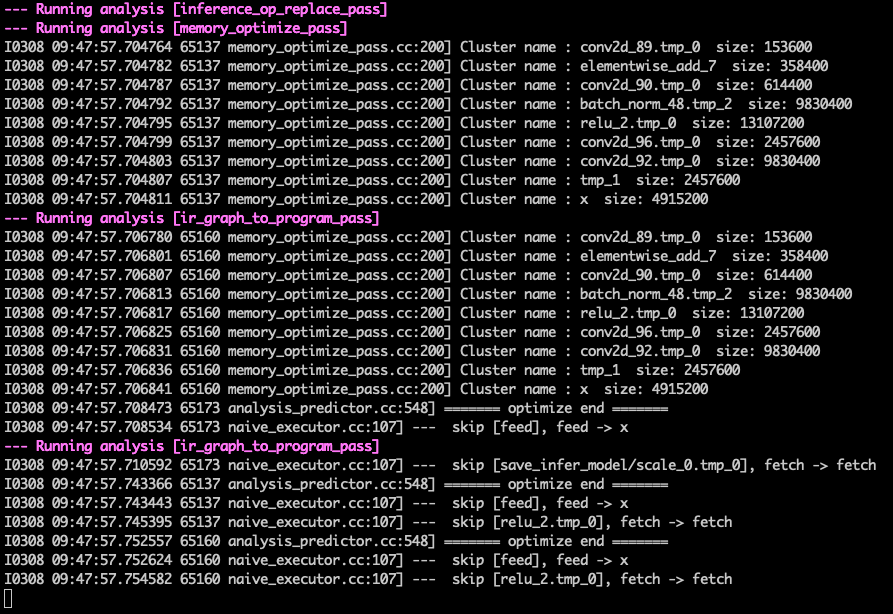|
|
||
|---|---|---|
| .. | ||
| imgs | ||
| README.md | ||
| README_CN.md | ||
| __init__.py | ||
| config.yml | ||
| ocr_reader.py | ||
| pipeline_http_client.py | ||
| pipeline_rpc_client.py | ||
| web_service.py | ||
README.md
OCR Pipeline WebService
(English|简体中文)
This document will introduce how to use the PaddleServing to deploy the PPOCR dynamic graph model as a pipeline online service.
Compared with hubserving deployment, PaddleServing supports high concurrency and efficient communication between the client and the server. The introduction and tutorial of Paddle Serving service deployment framework reference document.
Contents
- Environmental preparation
- Model conversion
- Paddle Serving pipeline deployment
- FAQ
Environmental preparation
Need to prepare PaddleOCR operating environment and Paddle Serving operating environment.
-
Prepare PaddleOCR operating environment reference link
-
Prepare the operating environment of PaddleServing, the steps are as follows
Install serving, used to start the service
pip3 install paddle-serving-server==0.5.0 # for CPU
pip3 install paddle-serving-server-gpu==0.5.0 # for GPU
# Other GPU environments need to confirm the environment and then choose to execute the following commands
pip3 install paddle-serving-server-gpu==0.5.0.post9 # GPU with CUDA9.0
pip3 install paddle-serving-server-gpu==0.5.0.post10 # GPU with CUDA10.0
pip3 install paddle-serving-server-gpu==0.5.0.post101 # GPU with CUDA10.1 + TensorRT6
pip3 install paddle-serving-server-gpu==0.5.0.post11 # GPU with CUDA10.1 + TensorRT7
- Install the client to send requests to the service
pip3 install paddle-serving-client==0.5.0 # for CPU
pip3 install paddle-serving-client-gpu==0.5.0 # for GPU
- Install serving-app
pip3 install paddle-serving-app==0.3.0
# fix local_predict to support load dynamic model
# find the install directoory of paddle_serving_app
vim /usr/local/lib/python3.7/site-packages/paddle_serving_app/local_predict.py
# replace line 85 of local_predict.py config = AnalysisConfig(model_path) with:
if os.path.exists(os.path.join(model_path, "__params__")):
config = AnalysisConfig(os.path.join(model_path, "__model__"), os.path.join(model_path, "__params__"))
else:
config = AnalysisConfig(model_path)
note: If you want to install the latest version of PaddleServing, refer to link.
Model conversion
When using PaddleServing for service deployment, you need to convert the saved inference model into a serving model that is easy to deploy.
First, download the [inference model] of PPOCR(https://github.com/PaddlePaddle/PaddleOCR#pp-ocr-20-series-model-listupdate-on-dec-15)
# Download and unzip the OCR text detection model
wget https://paddleocr.bj.bcebos.com/dygraph_v2.0/ch/ch_ppocr_server_v2.0_det_infer.tar && tar xf ch_ppocr_server_v2.0_det_infer.tar
# Download and unzip the OCR text recognition model
wget https://paddleocr.bj.bcebos.com/dygraph_v2.0/ch/ch_ppocr_server_v2.0_rec_infer.tar && tar xf ch_ppocr_server_v2.0_rec_infer.tar
# Conversion detection model
python3 -m paddle_serving_client.convert --dirname ./ch_ppocr_server_v2.0_det_infer/ \
--model_filename inference.pdmodel \
--params_filename inference.pdiparams \
--serving_server ./ppocr_det_server_2.0_serving/ \
--serving_client ./ppocr_det_server_2.0_client/
# Conversion recognition model
python3 -m paddle_serving_client.convert --dirname ./ch_ppocr_server_v2.0_rec_infer/ \
--model_filename inference.pdmodel \
--params_filename inference.pdiparams \
--serving_server ./ppocr_rec_server_2.0_serving/ \
--serving_client ./ppocr_rec_server_2.0_client/
After the detection model is converted, there will be additional folders of ppocr_det_server_2.0_serving and ppocr_det_server_2.0_client in the current folder, with the following format:
|- ppocr_det_server_2.0_serving/
|- __model__
|- __params__
|- serving_server_conf.prototxt
|- serving_server_conf.stream.prototxt
|- ppocr_det_server_2.0_client
|- serving_client_conf.prototxt
|- serving_client_conf.stream.prototxt
The recognition model is the same.
Paddle Serving pipeline deployment
- Download the PaddleOCR code, if you have already downloaded it, you can skip this step.
git clone https://github.com/PaddlePaddle/PaddleOCR
# Enter the working directory
cd PaddleOCR/deploy/pdserver/
The pdserver directory contains the code to start the pipeline service and send prediction requests, including:
__init__.py
config.yml # Start the service configuration file
ocr_reader.py # OCR model pre-processing and post-processing code implementation
pipeline_http_client.py # Script to send pipeline prediction request
web_service.py # Start the script of the pipeline server
- Run the following command to start the service.
# Start the service and save the running log in log.txt
python3 web_service.py &>log.txt &
After the service is successfully started, a log similar to the following will be printed in log.txt

- Send service request
python3 pipeline_http_client.py
After successfully running, the predicted result of the model will be printed in the cmd window. An example of the result is:

FAQ
** Q1**: No result return after sending the request ** A1**: Do not set the proxy when starting the service and sending the request. You can close the proxy before starting the service and before sending the request. The command to close the proxy is:
unset https_proxy
unset http_proxy